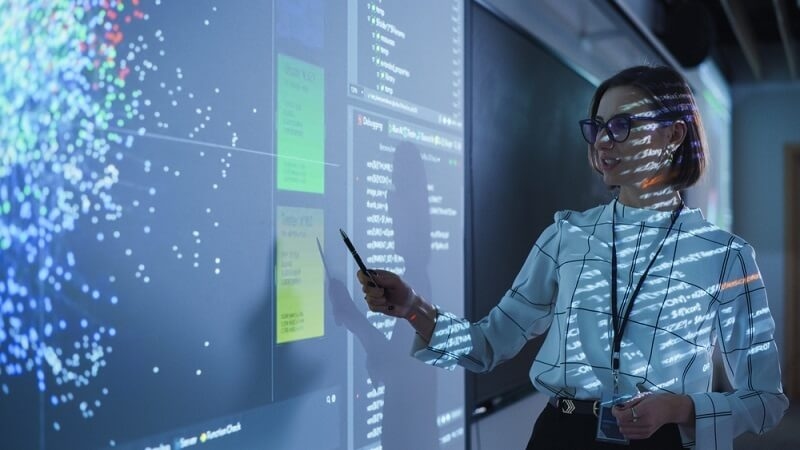AI in Education 2025: Can It Replace Teachers in US?

In 2025, AI in education is no longer a futuristic concept—it’s here, shaping classrooms in ways that were unthinkable a few years ago. Chatbots grade papers. AI lesson planners churn out custom study guides in seconds. Students chat with AI teaching assistants that answer questions instantly.
And yet, the question still lingers: Can AI replace teachers?
This is the heart of the teacher vs AI debate sweeping across the country. Some see AI as a powerful classroom ally. Others fear it could undermine the very essence of teaching. The reality is more layered than either side admits.
AI in Education 2025: Where We Stand
Walk into a U.S. classroom today and you’ll see the shift immediately.
Teachers are using AI to:
- Create personalized lesson plans in minutes.
- Automate grading, freeing hours each week.
- Get real-time performance analytics for every student.
In fact, surveys show over half of U.S. K-12 teachers now use some form of AI tool weekly. They’re not relying on AI to teach—they’re using it to cut down on repetitive work so they can focus on what actually matters: mentoring, motivating, and inspiring.
Districts are investing heavily. From rural schools in Tennessee to tech-forward districts in California, administrators are rolling out AI platforms with built-in safeguards to keep teachers firmly in control.
Inside the Teacher vs AI Debate
At the core of the teacher vs AI debate is a fundamental truth: teaching is more than delivering content. A chatbot can give a student an answer. It can even explain the reasoning. But it can’t read the room, sense frustration, or adapt a lesson based on subtle cues only a human notices.
Supporters argue AI frees teachers from burnout-inducing admin work. Critics warn overreliance could chip away at student critical thinking and create dependency.
Most teachers I’ve spoken to aren’t asking whether AI can replace them—they’re asking how it will change their jobs, and how to make sure those changes work in their favor.
Top Pick: Learn The Top Effective Teaching Strategies for Students
AI Teaching Assistants: Useful, But Not a Substitute

The term “AI teaching assistants” gets thrown around a lot. In reality, these tools are more like digital aides:
- They grade assignments instantly.
- Suggest targeted exercises for struggling students.
- Offer one-on-one tutoring in a chatbot format.
They’re efficient, but they’re not mentors. They don’t inspire a struggling student to push through. They can’t adapt teaching to the emotional state of the classroom. They can’t spot when a student’s silence means they’re lost—or when it means they’ve just had a bad day.
That human touch is what keeps AI in a supporting role, not a leading one.
What U.S. Schools Are Doing in 2025
The AI in education 2025 movement isn’t a free-for-all. Big steps are being taken to manage the rollout responsibly:
- Teacher training academies backed by tech giants are teaching educators how to use AI effectively and ethically.
- AI literacy programs are being built into student curriculums to prevent overreliance.
- Equity initiatives aim to make sure rural and underfunded schools aren’t left behind.
In some districts, principals have set up “AI Committees” where teachers test new tools before they’re approved. In others, schools are experimenting with hybrid classrooms—human-led but supported by AI that handles instant feedback, attendance tracking, and real-time performance reports.
The Future of Teaching Jobs USA
Here’s where things get real: AI will change what it means to be a teacher in America.
The future of teaching jobs in the USA won’t be about memorization drills or manual grading—it will be about guiding students through complex thinking, creativity, and collaboration.
We’ll see:
- Hybrid roles where teachers double as AI supervisors.
- Specialist positions like “AI curriculum strategist” emerging in districts.
- Increased demand for AI-literate educators who can manage these tools and use them to amplify learning.
Teachers who embrace the change will likely find themselves in higher demand than ever. Those who refuse to adapt may struggle to keep pace with the profession’s new expectations.
Don’t Miss: Learn How Blended Learning Enhances Student Engagement
The Risk of Getting It Wrong
While the potential is huge, the risks are real:
- Bias in AI systems can lead to unfair grading or skewed recommendations.
- Privacy concerns loom large, especially with student data being fed into third-party tools.
- Overdependence on AI can erode critical thinking skills if students use it as a shortcut.
Some districts are also concerned about “creeping automation”—AI quietly taking over more tasks until human oversight is minimal. That’s why responsible rollout and ongoing teacher control are non-negotiable.
The Big Picture: Why Teachers Still Matter
Even the most advanced AI teaching assistants can’t match what happens when a teacher connects with a student.
They can’t inspire passion for a subject.
They can’t coach resilience after a failure.
They can’t tailor motivation to the unique personality in front of them.
This is why, despite all the headlines, the teacher vs AI debate isn’t about replacement—it’s about evolution. AI isn’t here to erase teachers. It’s here to strip away the busywork so they can do more of the work that truly matters.
Looking Ahead
By the end of this decade, every U.S. classroom will likely have some level of AI integration. The future of teaching jobs in the USA will belong to educators who can balance human insight with technological capability.
In that future:
- AI handles the data, the grading, the logistics.
- Teachers handle the mentorship, the inspiration, the deep thinking.
- Education becomes more personalized without losing its human core.
The technology will keep advancing. But as long as learning remains a deeply human experience, teachers aren’t going anywhere.
You may also like: Best Educational Apps & Games for Kids | Top Picks
Final Word
So—can AI replace teachers? Not in the way alarmists imagine.
Yes, AI in education 2025 is powerful. Yes, AI teaching assistants make classrooms more efficient. But they’re tools, not replacements. The teacher vs AI debate isn’t about one winning over the other—it’s about how they work together.
And in the future of teaching jobs USA, the best educators will be the ones who don’t fear AI… but who know exactly how to make it work for them and their students.
This content was created by AI
